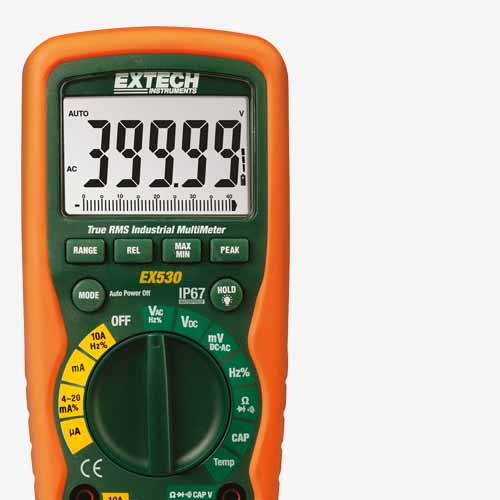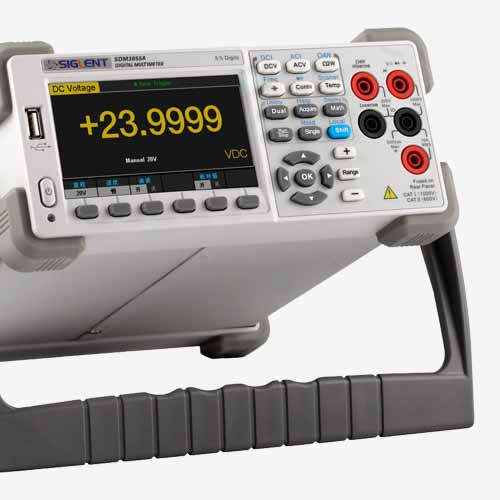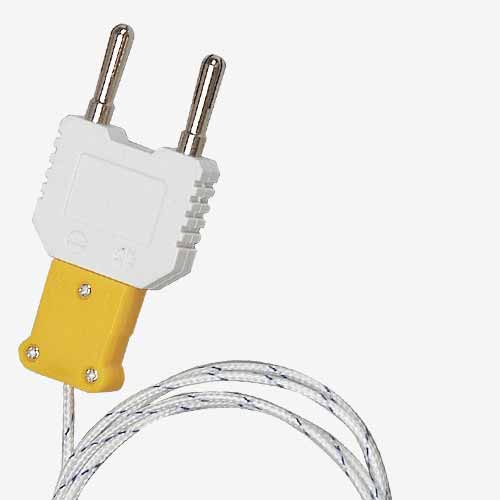About Multimeters
A multimeter is quite probably the most useful tool an electrician can utilise. These devices are pieces of testing equipment that allow for the measurement of more than one parameter by the use of the same device, and this means that users can choose the exact test procedure they want and use a multimeter to gain a measurement of that reading.
The capability of a multimeter depends entirely on the design and construction. Basic multimeters will generally be able to only measure such things as voltages or resistance across small ranges, but higher-end multimeters might be able to measure those same parameters across higher ranges, and also test things such as capacitance or temperature levels.
Multimeters are generally broken down into two distinct categories. The first of these - analogue - are devices that utilise electromechanical components to display a measured value. This means that the analogue multimeter displays results as a needle moving across a scale, or set of scales. They're generally best suited to detecting sudden fluctuations in measurement.
The other category is the digital multimeter or DMM. This device uses special electrical components to display measured values and it displays these results as a digital reading, usually on a built-in LCD screen. They are generally regarded as being more accurate than analogue devices and are used much more commonly in the modern testing industry.
These devices also vary greatly in size and appearance. It's quite usual for most electricians to be spotted out and about with a handheld multimeter that's portable enough to not be cumbersome, but there are also bench multimeters that are generally used in laboratory and calibration procedures that are capable of generating much more accurate results.
Popular Products
-
Fluke 117 (Digital): Compact, true RMS digital multimeter featuring non-contact voltage detection, auto-ranging, and a backlit display. A Combo Kit with the Fluke 117 is also available.
-
Kewtech KT116 (Digital): Features auto-ranging, a large backlit display, and multiple measurement functions.
-
Fluke 8808A (Bench): Reknown for its exceptional accuracy, versatility, and ease of use, its dual display and multiple measurement functions deliver reliable performance.
-
Siglent SDM3055 (Bench): A 5½-digit resolution, dual display, supports multifunctional and automated measurements.
-
Chauvin Arnoux MX1 (Analogue ): With a needle scale for accurate readings, it measures multiple electrical parameters and includes features like safety alarms and continuity testing. The Chauvin Arnoux MX1 can be purchased with a compatible protective case included.
-
Chauvin Arnoux CA5001 (Analogue): Capable of measuring AC/DC voltage, current, and resistance, and comes equipped with features such as continuity testing with an audible buzzer. We also provide the Chauvin Arnoux CA5001 & Case, so you can keep your instrument protected and easily transport it.
-
Megger 2011-017 Soft Pouch: Durable, protective case designed to safeguard Megger multimeters during transport and storage.
-
Fluke 648961 Tilt Stand: Designed to provide a stable and adjustable platform for Fluke multimeters. Its ergonomic design enhances visibility and accessibility.
-
Extech TP873 Bead Wire Type K Temperature Probe: Capable of measuring temperatures between -30°C and 300°C (-22°F to 572°F). It has a bead wire construction and works with most multimeters that support Type K temperature inputs.
FAQs
-
How do you use a multimeter to measure voltage?
A digital multimeter (DMM) measures electrical properties like voltage, current, and resistance using an analogue-to-digital converter (ADC) to display readings digitally. It connects in parallel for voltage, in series with a shunt resistor for current, and passes a small current for resistance. Additional functions include diode testing, capacitance, frequency, and temperature measurements. Key components like amplifiers, attenuators, a microcontroller, and a display unit. -
How do you measure resistance with a multimeter?
First, ensure the circuit is powered off. Set the multimeter to the resistance (ohms) mode. Insert the black probe into the COM jack and the red probe into the VΩ jack. Touch the probes to the two ends of the component whose resistance you want to measure. The multimeter will display the resistance value on its screen. For accurate readings, ensure good contact between the probes and the component, and if possible, measure the component out of the circuit to avoid interference from other components. -
What are the different types of multimeters?
There are several types of multimeters, each suited for different applications. Analogue multimeters use a moving needle to display readings and are valued for their simplicity and durability. Digital multimeters (DMMs) provide more precise readings on an LCD screen and often include additional features like auto-ranging and data storage. Clamp multimeters measure current without direct contact by clamping around a conductor. Autoranging multimeters automatically selects the appropriate measurement range, simplifying use. Each type offers unique advantages depending on the specific needs of the user. -
What features should I look for in a multimeter?
Accuracy to ensure precise measurements, resolution for detecting small changes, and auto-ranging to simplify use. True RMS capability is essential for accurate AC measurements, especially with non-sinusoidal waveforms. Consider build quality and durability for longevity, and ensure it meets relevant safety standards like IEC 61010. Additional functions like capacitance, temperature, frequency, and continuity testing can enhance versatility. A large, backlit display improves readability in low-light conditions. -
What is the difference between an analogue and a digital multimeter?
An analogue multimeter uses a needle and a scale to display readings, which can make it harder to read precise values but allows for observing trends and fluctuations in real time. In contrast, a digital multimeter provides readings on a digital display, offering greater accuracy and ease of use, especially for precise measurements. Digital multimeters often come with additional features like auto-ranging, data hold, and more advanced functionalities, making them more versatile for various applications. -
How do I test a battery with a multimeter?
Set the multimeter to the DC voltage setting. Connect the red probe to the positive terminal and the black probe to the negative terminal of the battery. Read the voltage displayed on the multimeter; a fully charged battery should show a voltage close to its rated value. If the reading is significantly lower, the battery may be weak or dead. -
What does the continuity function on a multimeter do?
It checks to see if there is a complete path for current to flow in a circuit. When you use this function, the multimeter sends a small current through the circuit and beeps if the circuit is complete. This helps identify broken wires, faulty connections, or components that are not properly connected. -
How do I measure current with a multimeter?
Set the multimeter to the appropriate current range (AC or DC). Insert the red probe into the port labelled for current (often marked as “A” or “mA”) and the black probe into the common (COM) port. Connect the multimeter in series with the circuit, ensuring the current flows through the meter. Read the current value displayed on the multimeter. -
What is the diode test function on a multimeter?
The function checks the health of a diode by applying a small voltage and measuring the voltage drop across it. A good diode will show a specific voltage drop when forward-biased and no current flow when reverse-biased. This helps determine if the diode is functioning correctly. -
What safety precautions should I take when using a multimeter?
Always ensure you are using the correct settings for your measurements to avoid damage or injury. Inspect the multimeter and test leads for any damage before use. Never touch the metal parts of the probes while taking measurements, and be cautious when working with high voltages to prevent electric shock. Always start with the highest range if you are unsure of the voltage or current levels, and work in a dry environment to reduce the risk of electrical hazards.


 Digital Multimeters
Digital Multimeters
 Bench Multimeters
Bench Multimeters
 Analogue Multimeters
Analogue Multimeters
 Multimeter Accessories
Multimeter Accessories
